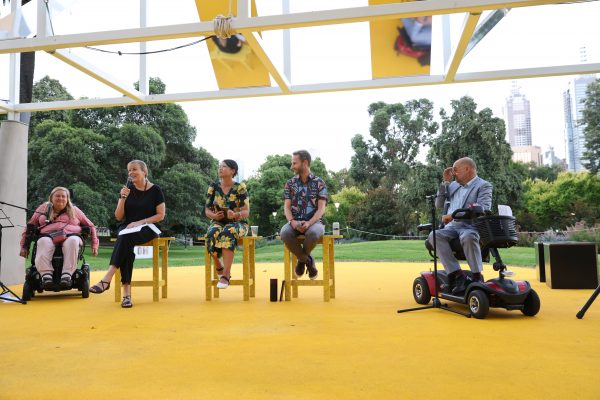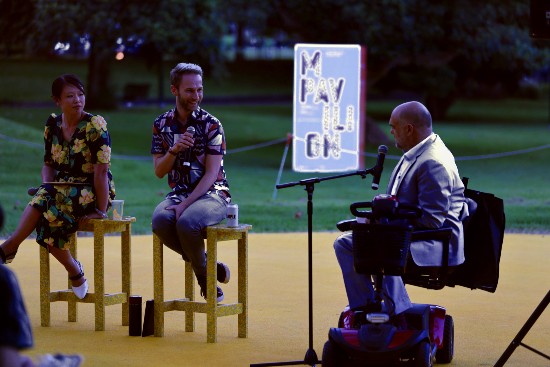At the MPavilion, where the community comes together to engage and share
Architecture & Access Architect Tim Randall recently spoke at a forum at the MPavilion, located in Alexandra Gardens on the topic of “Disability, human rights and the built environment.” The event was curated by Mary Ann Jackson and her team from Visionary Design Development with speakers approaching the topic from a number of different angles.

Disability rights advocate Raelene West expressed her incredulity at the perception that the design industry moves and changes quickly, clearly articulating the slow pace in which it takes to improve access for wheelchair users such as her. She shared a memorable example of her local fish and chip shop where for many years she has had to shout her order from the front door because of a small step that keeps her from crossing the threshold.
Via audio recording from Ireland, architect and academic Bernadette Egan echoed Raelene’s experience. She informed the audience that the first accessibility building standard was introduced in the USA over 60 years ago, but as someone who acquired a disability later in life, she found her human rights were suddenly diminished as a result. Bernadette emphasised these rights are enshrined in the United Nations Convention on the Rights of Persons with Disabilities, which explains that freedom of movement is a precondition for disabled people to enable them to participate fully and equally in society.
Yvonne Meng is an architect currently completing her PhD research on footpaths and the complex role they have in our cities. They make up the vast majority of public space, and whilst their primary purpose is for pedestrians, they are a contested zone, with shared ownership and rights of use. “The smallest detail – a misplaced step, a poorly positioned pole, or merchandise spilling from the shops can make mobility difficult for some groups.”
Tim was the final speaker on the panel and spoke about the responsibility architects have when drawing; establishing boundaries which can invite people in or exclude them. He reminded the audience of how it feels to miss out on the things we love:
“This trying lockdown experience we have shared, should give us a good sense of the importance of [Art, culture, parks, sport, nature, good food, good company, personal interaction] in our lives, and the personal impact of barriers placed on them… Many of these things are shared in common in public space, and it is that coming together in the public domain that is central to strengthening our bonds as a society and a community.”
MC Peter Raisbeck, shared his own poem which referred to AS1428 which Tim also referred to: “The Australian Standard for Access to Premises which is enshrined in law for public buildings. We can use this as a tool, not just to redesign space but also to redesign peoples’ relationship to it, and perhaps in turn their relationship with their community.”
“…the complexity comes when balancing the needs of other users of a building, able bodied individuals, [sometimes] carers and staff – creating a safe and dignified work environment for them, whilst balancing all of this against the typical architectural constraints of site, budgets, clients’ preferences, environmental sustainability, building regulations and heaven forbid; beauty.”
“I believe that all of this begins with dignity at home. Much of our work is in the domestic setting and is primarily centred on meeting people’s functional requirements. Restoring a sense of dignity and providing independence so that at a bare minimum the necessities of daily living can be achieved with relative ease, hopefully saving efforts for negotiating life outside the home, to contribute and share life with other members of the community.
Tim finished by connecting this important work to his own personal motivation: “What continues to drive me is a belief that everyone should have the same rights and opportunities that I enjoy as an able bodied, straight, white male. Design has a roll to play in facilitating this, not creating barriers but opportunities.” A similar impulse is shared by many who work at Architecture & Access as we seek to uphold our vision of “Creating environments, transforming lives.”
This link will provide you with a recording of the discussion.
